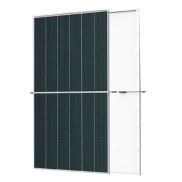How Solar Modules Power Photovoltaic Systems ?
Time of Release : 2023-11-20
Unleashing the true potential of solar energy, photovoltaic (PV) systems have emerged as a beacon of hope in our quest for sustainable electricity generation. At the core of these systems lie solar modules, which tirelessly convert sunlight into clean, renewable energy. In this article, we will embark on a journey to understand the mechanics behind solar module operation and their pivotal role in fueling photovoltaic systems. So, let’s delve into the secrets behind this shining technology!

Solar Modules: Harnessing the Sun’s Power:
Solar modules, commonly known as solar panels, serve as the essential building blocks of PV systems. These remarkable devices consist of interconnected solar cells, often composed of crystalline silicon, which exhibit the extraordinary property of the photovoltaic effect. When sunlight interacts with the solar cells, an incredible transformation occurs as light energy is converted into direct current (DC) electricity.
Photons and Electrons:
When radiant sunlight strikes the surface of the solar cells, it delivers tiny packets of energy known as photons. These energetic photons stimulate the electrons within the solar cells, causing them to gain energy and break free from their atomic bonds. As the number of liberated electrons increases, an electric current flows, providing a tangible source of clean energy.
The Vital Role of the Inverter:
While DC electricity is valuable, most residential and commercial electrical systems operate on alternating current (AC). To bridge this gap, the solar modules work in tandem with a critical partner—the inverter. The inverter serves as a master translator, skillfully converting the DC electricity generated by the solar modules into AC electricity, making it perfectly compatible with our everyday appliances and the power grid.
Powering Our World:
Once solar energy has been converted into AC electricity, it is poised to fulfill its purpose—powering homes, buildings, and beyond. Solar modules are often strategically mounted on rooftops or open areas, optimized to capture as much sunlight as possible. The electricity generated flows into the electrical system, providing a reliable and clean power source for all our needs. By harnessing the sun’s energy, solar modules pave the way for reducing reliance on conventional energy sources and fostering a sustainable future.

Grid Interaction:
For those connected to the electrical grid, PV systems present an exciting opportunity for a symbiotic relationship. During periods of ample sunshine, solar modules often produce more electricity than needed. Rather than going to waste, this surplus energy can be fed back into the grid, powering neighboring homes and businesses. In return, when sunlight is insufficient, electricity can be drawn from the grid, ensuring a consistent supply of power. This two-way interaction promotes energy independence and contributes to overall grid stability.
Solar modules are the unsung heroes of the renewable energy revolution, harnessing energy from the sun’s rays and transforming it into a sustainable and accessible power source. With every ray of sunshine, these modules illuminate our path to a greener future, reducing our carbon footprint and mitigating climate change. As solar technology advances, the efficiency and affordability of solar modules continue to improve, making them increasingly vital in our quest for a clean energy-powered world. Let’s embrace the brilliance of solar modules and bask in the radiance of a brighter, greener future!





